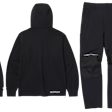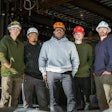
The choice of the type of construction work pant is dictated by the work being done and the toughness and durability required, among other factors. Comfort is another factor as most workers throughout the U.S. are entering the cold weather season.
Cargo pants and utility pants are two common considerations. Each choice differs in fabric utilization, functionality, design and fit, and purpose.
Cargo pants are typically made with thicker material such as polyester, cotton or cotton blend fabrics, canvas, ripstop or denim for outdoor durability.
Cargo pants were originally designed for military use – introduced in the U.S. during World War II and favored for their large pockets that enabled troops to carry needed items such as maps, field dressings, K-rations, and extra ammunition.
Cargo pants may have a looser, more relaxed fit with ample leg room for ease of movement.
It comes as no surprise that cargo pants are favored by some construction workers. Cargo pants offer the ability to carry items needed on the job with the abundance of bellow-style pockets and the integration of belt loops to carry tools and supplies. That functionality may be preferred by those who do not want to wear a tool belt.
Fabric choices for utility pants may include chino cloth, which is lightweight and breathable, as well as ponte knit, a soft and stretchy fabric crafted from a blend of rayon, nylon, and spandex.
Utility pants often have a slimmer, relaxed or straight fit. They typically have fewer and more streamlined pockets in which smaller essential items can be carried. Utility pants have a gusseted construction, offering enhanced mobility, and a built-in belt for an adjustable waistline.
Utility pants also may feature reinforcement in the knees and crotch areas, which enhances mobility and comfort when climbing, bending, or squatting.
In choosing either type of pants, factors such as the need for durability to withstand the wear and tear working on a construction site will bring, while breathability and flexibility are important while working long hours.
Reinforced knees and seams help mitigate wear. Double-front pants or those offering the option to insert knee pads are beneficial for jobs involving a lot of kneeling.
Cold weather work may call for pants with moisture-wicking properties, water resistance, or thermal lining.
Another consideration as workers are entering the cold weather season in most of the United States is to utilize base layer pants – also known as long underwear, thermal underwear, leggings, and long johns as long as they meet safety requirements.
This IRONPROS story examines how being prepared by having the right type of pants ensures a construction worker is best protected for whatever a job requires in various weather conditions.
If working in low-light or high-traffic conditions, consider wearing pants with reflective strips or in high-visibility colors. Look for ANSI Class E apparel, a supplemental classification of an apparel type designed to increase visibility. EN ISO 20471 Class 2 offers an intermediate level of visibility.
Fire-resistant materials add a level of safety when working around sparks. The National Fire Protection Association (NFPA) 2112 Standard provides minimum requirements for flame-resistant garments. Ratings are provided by the NFPA and the American Society for Testing and Materials.
Flame resistant garments certified by Underwriters Laboratories meet the requirements of NFPA 2112 Standard on Flame Resistant Garments for Personnel Against Flash Fire, 2007 Edition.
Stain-resistant fabric will help with ease of maintenance.
OSHA notes women’s construction apparel should be based upon female anthropometric (body measurement) data. The best pants for women may feature a contoured waistband to prevent gapping in the back. A higher rise in the back accommodates a curvier lower back. Women’s construction work pants often feature curvature in the hip and thigh.
Women’s construction pants may have a shorter inseam length to cater to generally shorter average height compared to men and feature a crotch gusset. Brands offering maternity work pants typically offer a wide range of sizes and stretch materials to cater to the various stages of pregnancy.
This IRONPROS story delves deeper into these factors. Additional considerations for maternity pants can be found in this IRONPROS story.
Consult with a safety manager to ensure clothing being worn at the jobsite meets all safety requirements.
















